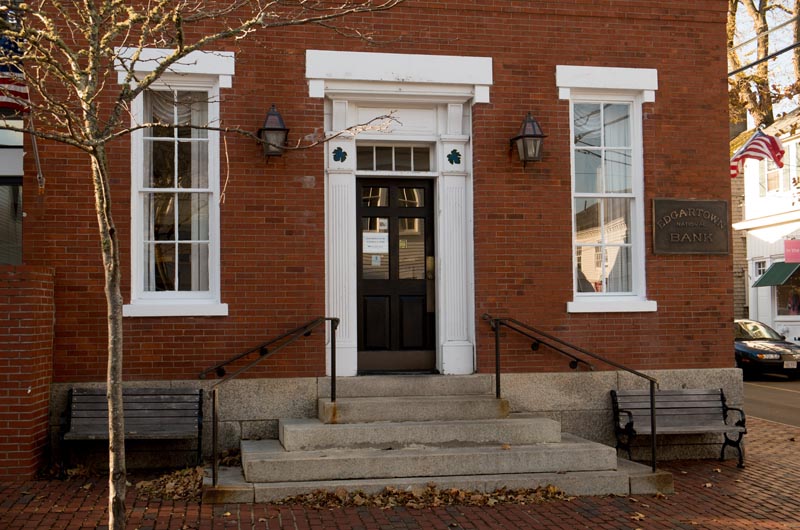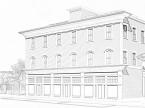The Edgartown National Bank has received high marks on a report card from regulators, exceeding even its own expectations.
Last spring, the bank was awarded the coveted rank of “outstanding” under the Community Reinvestment Act, a rare achievement for an Island bank.
The act, which passed in 1977 and applies to banks nationwide, encourages banks to meet the credit needs of their communities.
Banks are rated outstanding, satisfactory or needs to improve depending on how well they comply with the CRA. Until now, the Edgartown National Bank has received a satisfactory rating.
The evaluation rewards banks that provide sensible loans to low and moderate income families. And that is why banks on the Island do not usually achieve more than a satisfactory rating; affordable housing is scarce and low and moderate-income families often do not earn enough to buy a house.
“Because wages are low and home prices are high, it makes it more difficult for people to qualify for a loan,” said the bank’s community reinvestment officer, Delos (Dee) Lander.
Mr. Lander said there is no housing on the Island that meets the definition of low-income housing.
“When a category doesn’t exist, it’s very hard for us to serve that category, which is the catch-22 in all of this,” Mr. Lander said. “That is why it’s especially hard for us to earn an outstanding rating. In order to do that we have to go above and beyond in other areas.”
Lately, above and beyond has meant lending to affordable housing groups, including the Island Housing Trust, which has received financing from the bank for recent construction projects including rental housing on Clam Point Road in West Tisbury.
The bank also applied for a $160,000 grant on behalf of the Island Housing Trust to subsidize that project, which was recently completed.
According to the evaluation, the bank originated 11 community development loans to affordable housing groups since 2008, totaling $5.7 million. Regulators also noted support for community development groups in the form of event sponsorships and donations.
“I think we have always been a very strong satisfactory and I think the work we are doing in the area of affordable housing and the grants we were able to secure made the difference,” Mr. Lander said.
Edgartown National Bank president and chief executive officer Fielding Moore said in more than 40 years working in community banks, he’d never seen a community bank of their size get an outstanding rating. He said the bank was being recognized for providing loans and grant assistance to local organizations that create badly needed affordable housing.
“It’s a huge problem and there is a lot more to be done,” Mr. Moore said. “I am not sure how much of a dent we have made, but at least we are doing some small part to help alleviate the problem.”
The Edgartown National Bank is evaluated every five years by the Office of the Comptroller of the Currency, a federal agency.
The OCC assessed the bank in part on a sampling of loans from a two-year period ending in 2013. They look at whether the loans stay within the community, and whether those loans benefit disadvantaged groups, like minority and women-owned businesses, and individuals with lower incomes.
Out of the 20 loans the evaluator looked at, all were made out to borrowers in Dukes County, but only one was made to a low-income borrower.
“While only one loan in our sample was originated to low-income borrowers, when considering the affordability of housing in the assessment area and the current economic conditions, this performance is reasonable,” the evaluator wrote.
In Dukes County, wages are 29 per cent below the state average and home prices are 54 per cent above, according to the most recent Martha’s Vineyard Housing Needs Assessment.
The affordability gap makes it hard for banks to give home loans to these groups, the report said.
“Given the bank’s size, relative to its competitors, the level of community development loans, investments and services to low-and moderate income individuals offers further support for the outstanding rating,” the report read in part.
As of March, the bank had $161 million in assets. Assets have grown by 31 per cent since 2008, the date of the last CRA exam, though the exam does not evaluate banks on their financial condition.
“The fact that the bank is doing well and we are growing deposits and we are growing loans and we are growing market share reflects on the bank’s overall performance and I think that carried over to CRA rating, but it’s an indirect link,” Mr. Lander said.
Going forward, the bank will continue to pursue the high rating, bank leadership said.
“Our plan is to continue to support the organizations in our community, especially those that meet the CRA criteria,” he said.







Comments
Comment policy »